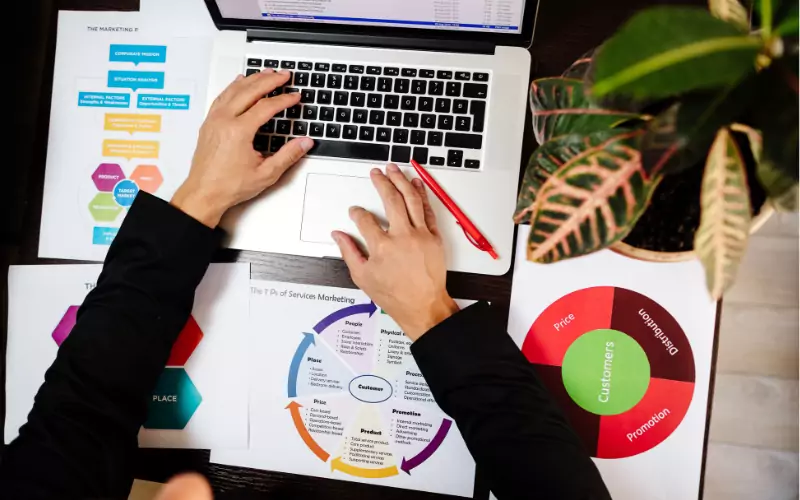Product design is a definitive process, involving the structuring of ideas around a design, based on its variabilities, and following it up with its implementation. The input variables include the type, quantity, and quality of raw materials involved in the design. Also, the types of raw material processing are considered to bring a design to life. Once these aspects are sorted out, they are streamlined in a definitive, time-effective flow. The challenge is to set the parameters of the flow in a way that exhibits the design principles involved.
Product design ideation commences with understanding potential customer pain points around an idea. The idea is passed through various stages of validation, and implemented with accuracy, to meet user needs centered around the given product. Product design is thus an effective tool in problem-solving and setting the benchmarks of an ideal user experience.
The entire process is ideated on a thorough systematic approach. The design method involves several stages, with each stage continuing from the previous stop-point. The process involves the contribution of professionals with various capabilities because product design incorporates principles of mechanical engineering, graphic design, and project management. Once the collaboration between stages is achieved, the product is understood to be ready for the market. A systematic approach ensures the optimum use of time and resources to make this happen.
Defining Product Design
Product design, in summation, refers to the comprehensive application of design principles with other aspects such as marketing, accounting, and engineering to achieve a desired design. The design serves a threefold objective. The goals of product design are thus defined as the criteria involved in bringing a new product to the market, making it marketable, and witnessing a growth in revenue from the successful applications of the principles involved.
The scope of product design has long since shifted from solely physical products, as digital products have also come into circulation. While the broad processes involved in both physical and digital products may be the same, they vary significantly in the way these broad parameters are applied. A digital design predominantly involves excellent coding and graphics skills and is focused more intently on the digital user experience. The physical product on the other hand sees graphics taking a backseat with ergonomics taking over, making the final product ready for a physical user experience.
Design thinking plays a foundational role in exacting the design process because it takes into account the end-user experience in formulating the process. Emphasizing human-centric designs instead of relying exclusively on quantitative data helps to attain the desired outcome.
The user experience design process is one of continuous refinement. To maximize the usability and appeal of their designs, UI/UX professionals can benefit greatly from testing concepts and prototypes with users in the early stages and at multiple points throughout development. Iteratively evaluating designs enables designers to identify issues, gather insights, and make improvements while designs are still malleable.
This cyclical approach of testing and enhancing also reduces uncertainties that may arise if user research and feedback are left until late in the process. By taking an iterative approach, designers can create experiences that are highly intuitive, satisfying, and captivating for their target users.
The Product Design Process Overview
The product design process involves a practical assessment of the entire life cycle of a product, from design to strategy, and from engineering to graphics, finally to marketing. Furthermore, the design process involves an understanding of all stakeholders and components of the design to develop a product that has a specific positive impact on the customers. Product design effectively states the competitive benchmark upon which a product performs in the long run, whether it’s physical or digital.
The design process can be ideated as a simplified four-step method: Discover, Define, Develop, and Deliver. The first two stages, namely Discover and Define are predominantly theoretical whereby the practical aspects of the process are set in order. The scope and applicability of the designed product are taken into consideration, along with the practical parameters of achieving the final output. This is then followed up in the design process where the parameters are set by testing the most successful prototypes for a successful delivery of the product.
The entire process relies on the adaptability of the system with the specific criteria of the industry where the product belongs. The process must fit into budget, time frame, and user expectations. A successful application of design thinking is imperative in achieving this ultimate outcome where the different parameters are experimented with for the final result to be on the table. Physical design and digital design have different criteria, which must be fulfilled accordingly, with the end objective of developing a product that matters to the end user.
Key Stages of the Product Design Process
Interpreting the key stages of the product design process with industry-specific criteria is a vital aspect for the product manager. The designer team is driven to collaborate on these aspects to achieve the required effect, which eventually translates into a better and marketable user experience.
Step 1: Research
Researching is understood as the fundamental aspect of the design thinking process. The UI/ UX designer deploys the researched variables to understand the gaps between applicability and usability in the end experience.
The designer thereby tests different automated solutions to build prototypes and deploy them through experimental applications before finalizing the process. Researching involves a comprehensive study of the market, at par with the user pain points to find out whether the final design would have an effective outcome.
Researching depends on the extrapolation of real-time and historical data to understand how the product would potentially fare in the market. In a competitive market, product redesign is also employed to understand why a current design should change, and how to achieve these changes from theory to practice. User interviews and surveys are conducted to achieve this purpose effectively.
In the research phase, the product designer must facilitate effective collaboration between various stakeholders to achieve a highly usable design. At all stages, the accountability of the designer remains affixed in achieving the most with the necessary minimum.
The resources are evaluated, classified, and applied in an iterative process. The entire process also elicits the need at all stages whether a said design is running successfully. Client feedback and last-minute changes are all too common.
Step 2: Ideation
The designer must see the forest for the trees. Simplifying project needs, aligning design with development, and getting stakeholders to agree—these efforts allow the designer to craft solutions for the challenges at hand. But product design involves more than aesthetics alone.
The design must be coherent with the bigger picture, identifying ways to maximize value and impact. This bird’s eye perspective makes design integral to any business strategy. By balancing the details with the broader vision, designers create products that are both useful and delightful.
Various ideation techniques are deployed. At every stage, the design is supplemented by a see-easy sketch that defines all parameters effectively. Along with that, the product designer is entrusted with successful user-journey mapping to achieve the final results. To make the product marketable, the designer also has to develop storyboards concurrent with the user journey. The idea behind ideating is to develop a design that successfully withstands an overtly competitive landscape.
Certain features are prioritized at various steps of the ideation. The prioritization is done to obtain the maximum impact. What is prioritized in the design process, is the same aspect that makes a difference in the user experience. Therefore, even while assigning various key roles, the ultimate objective of creating a product that does not fail the underlying principles of good design is strategically kept in focus.
Step 3: Design
When developing a prototype, the goal is to materialize concepts and determine the optimal path forward. If addressing multiple challenges, the design integrates all preferred resolutions into one prototype. This allows you to validate that the solutions operate harmoniously as an integrated system.
A prototype enables the designer to experience and interact with a concept instead of just imagining it. This hands-on evaluation reveals insights that fuel refinement. By investigating solutions holistically in a prototype, the designer can identify how to craft an exceptional product or service that delivers on all fronts.
Designing digital products would require the application of a unique set of design principles. The digital product must be made to fit in the information architecture schematics of the design. In other words, the product must fit in with the informational needs of the design, where users can find viable real-life applications.
Prototype testing in digital products is decidedly less cost-intensive than developing a physical product. The aspects of wireframe technology are utilized in both digital and physical products. However, from the digital perspective, the purpose is to get the product to deliver an intangible yet enjoyable user experience in the end.
The differences between tangibility and intangibility are yet the parameters that set the benchmarks between physical and digital dimensions. A physical product, to offer a robust user experience, must take into account all the real-world factors apart from the emotional aspects of the user experience. The streamlined process effectively involves sketching, rendering, and prototyping within the set time limit to achieve a successful design.
Step 4: Testing and Iteration
Following up with the development of the prototypes, the testing and iteration phases are initiated. Though one has arrived at a functional prototype, rigorous testing must still be conducted to ascertain if it truly resolves the issues identified during the problem definition phase. When constrained by time or finances, guerilla usability evaluations present a viable alternative to recruiting participants.
Do note, however, that this stage marks merely the conclusion of one design thinking cycle. Should testing unveil usability flaws, the prudent course involves reexamining the problem definition and reiterating earlier steps, thus launching a new cycle. Through successive iterations, the probability of devising an optimal solution grows ever greater.
As far as time and finances are allocated, repeated testing and iterations are conducted to achieve the desired outcome. Again, at every stage of the cumulative design cycle, the ultimate user experience parameters are kept paramount and understood as integral to the success of the design. In so much as the final product design is validated, it typically involves repeated testing and concurrence with real-world feedback to find out how the product will perform.
Step 5: Development and Launch
Once the prototype testing is finalized, the product design moves on to its final phases. The parameters of product development are set with collaborative milestones at every stage of the development process. The designers, developers, and manufacturers must be working on the same page to achieve what was originally meant by the product.
Once the product design team has set the benchmarks for development, the product is made ready for the design handoff process. When done thoughtfully, design handoff fosters clear communication and shared understanding.
Through detailed specifications, annotations, and conversations, designers can provide vital context about the design intent, user journeys, and business goals. Where relevant, the shared design system is reinforced, enabling developers to consistently implement patterns and components.
When the developers have finalized the product, it is considered ready for launch. At this stage the focus of product design shifts from creating the user experience to marketing it in the right way. Important feedback from all stages of the design cycle, especially the testing and prototype phases are incorporated for a successful launch.
Post-Launch: Monitoring and Iteration
After the product is launched, sufficient time is allowed to monitor its performance and match the same with the predicted experience. User feedback data from every phase of the product life cycle is understood and applied in the subsequent design principles. While a product is live, the various stages of the design process are recounted to understand the potential for improvements.
The testing and iteration phase is extended even after the product launch. It effectively sees that the product in question is in line with current market trends and user needs. At this stage, a proper assessment of user needs is also evaluated. A false or wrong prediction of user need, if it might have been incorporated in the design is identified and rectified in real time. The designers and developers then change the parameters of the redesign process.
Such continuous improvement, in effect, improves product sustainability over the long term. It strategically ensures that the product is adaptable to market conditions and is a truly timeless design. Achieving this level of perfecting would require a thorough and detailed oversight of the entire process outlined here.
Conclusion
In summation, the product design process involves the visualization and implementation of systematic design principles in achieving the desired outcome of a positive user experience. The importance of successful product design is easily understood, as it is the core comprehensive method by which a product is brought to life from the design table. The design process also sets the parameters for perfecting the user experience through collaboration between all stakeholders involved.
The various stages of the design process should be interpreted as cyclical rather than linear. At any stage of the design process, it may be important to recount the previous phases and correct a significant flaw that has been overlooked in the previous prototype. The importance of researching cannot be over-emphasized as at every stage of the methodology, adequate research is applied to define the ideal parameters.
The ultimate objective is achieved, and the product is ready to perform. Whether it’s a digital or a physical product, it implies the objective of balancing business objectives against user needs. Furthermore, while defining pre-emptive standards of UX, it is important not to make presumptions and achieve the needful without the need for further iterations.
Codewave is a design thinking led digital transformation company enabling organisations with playful innovation using AI & ML, IoT & Edge, AR, VR, Cloud, Blockchain, and Data.






